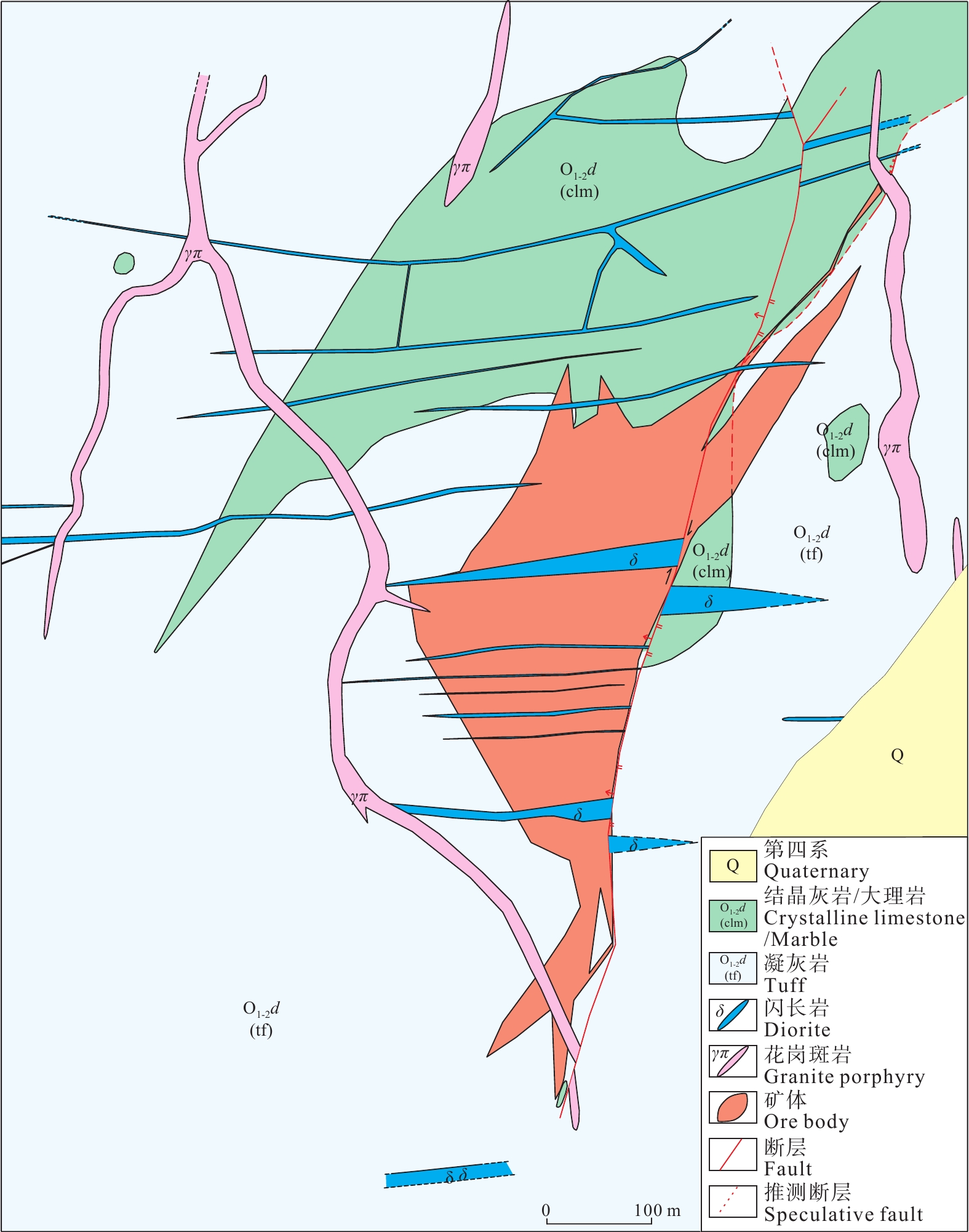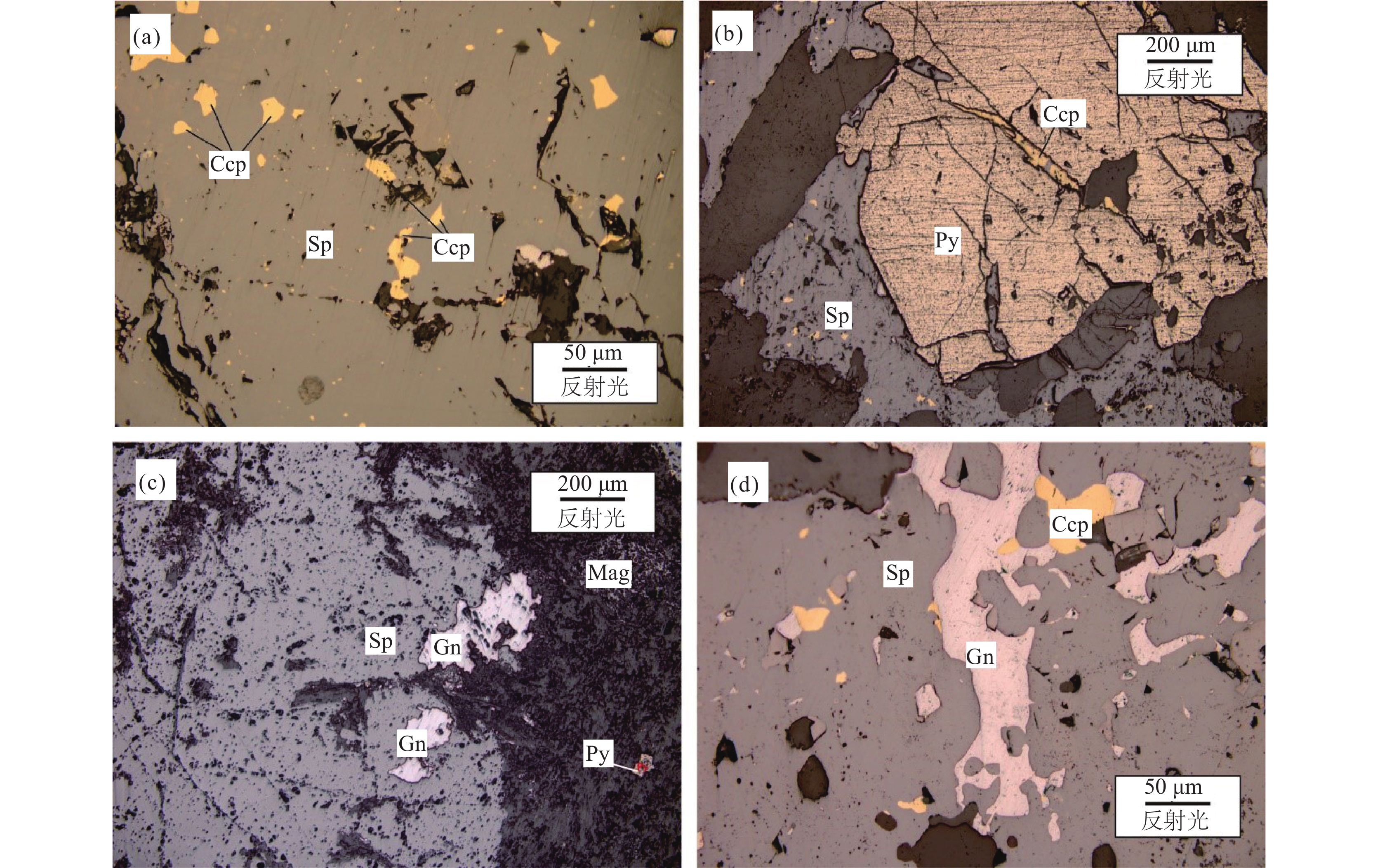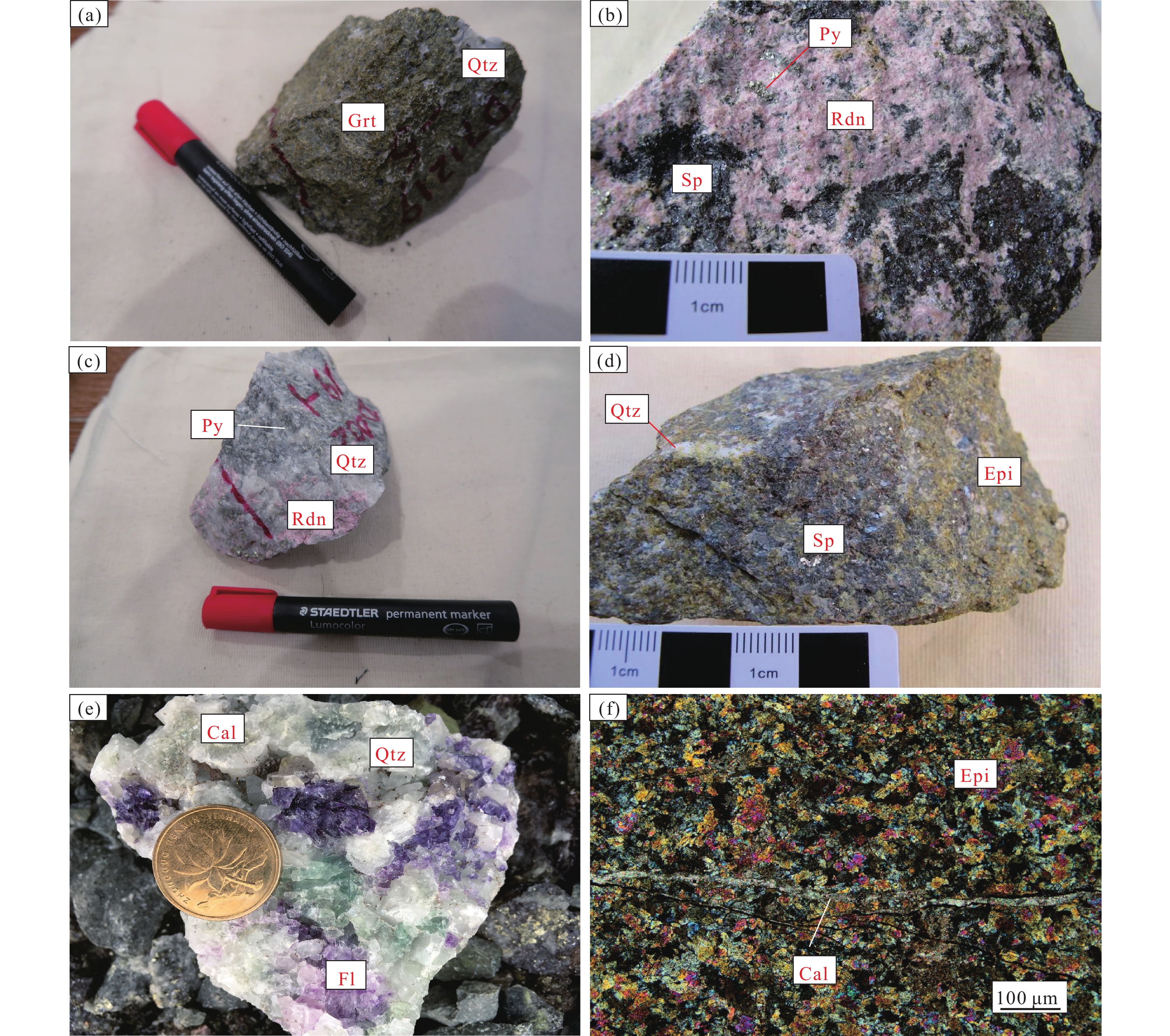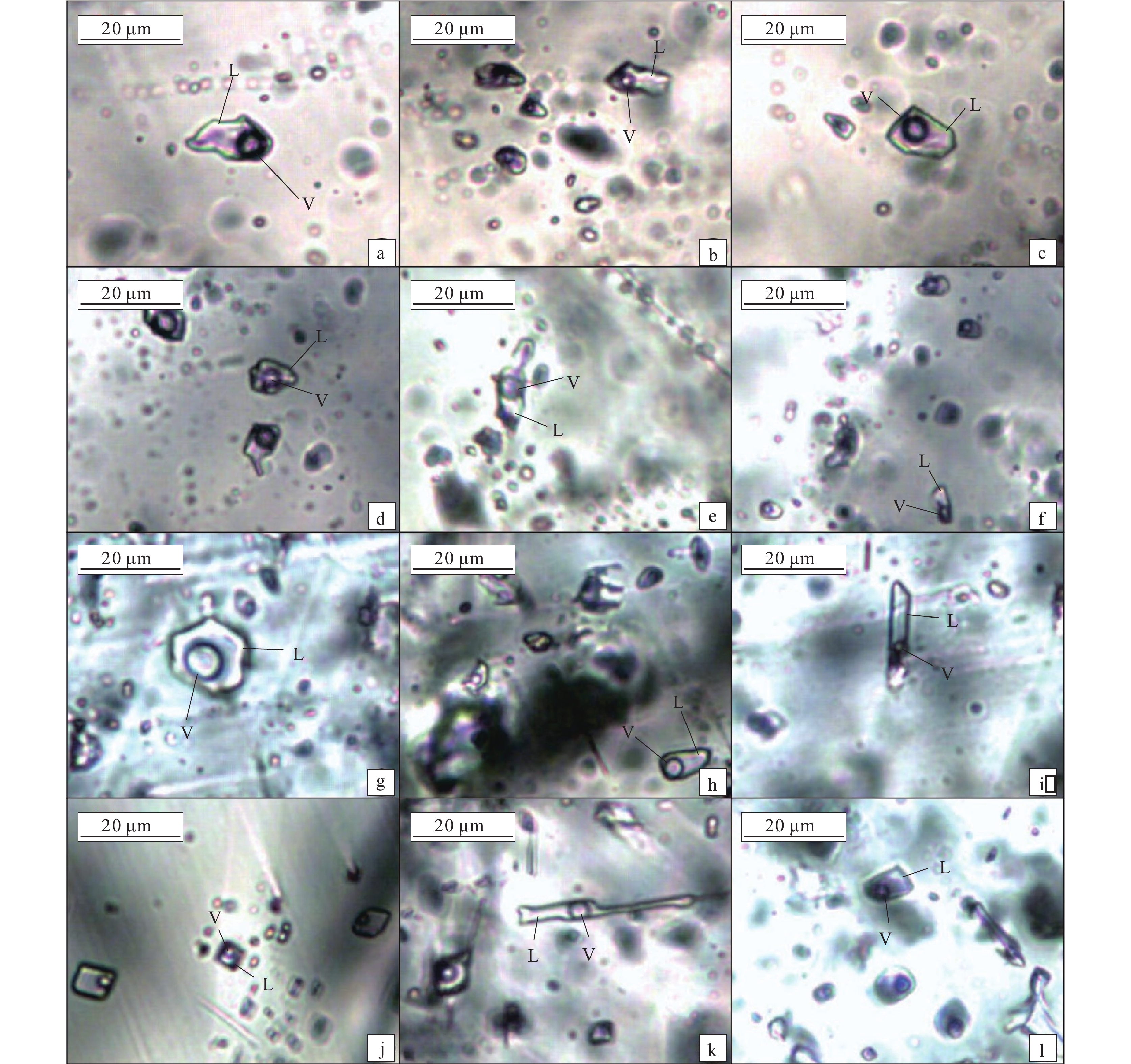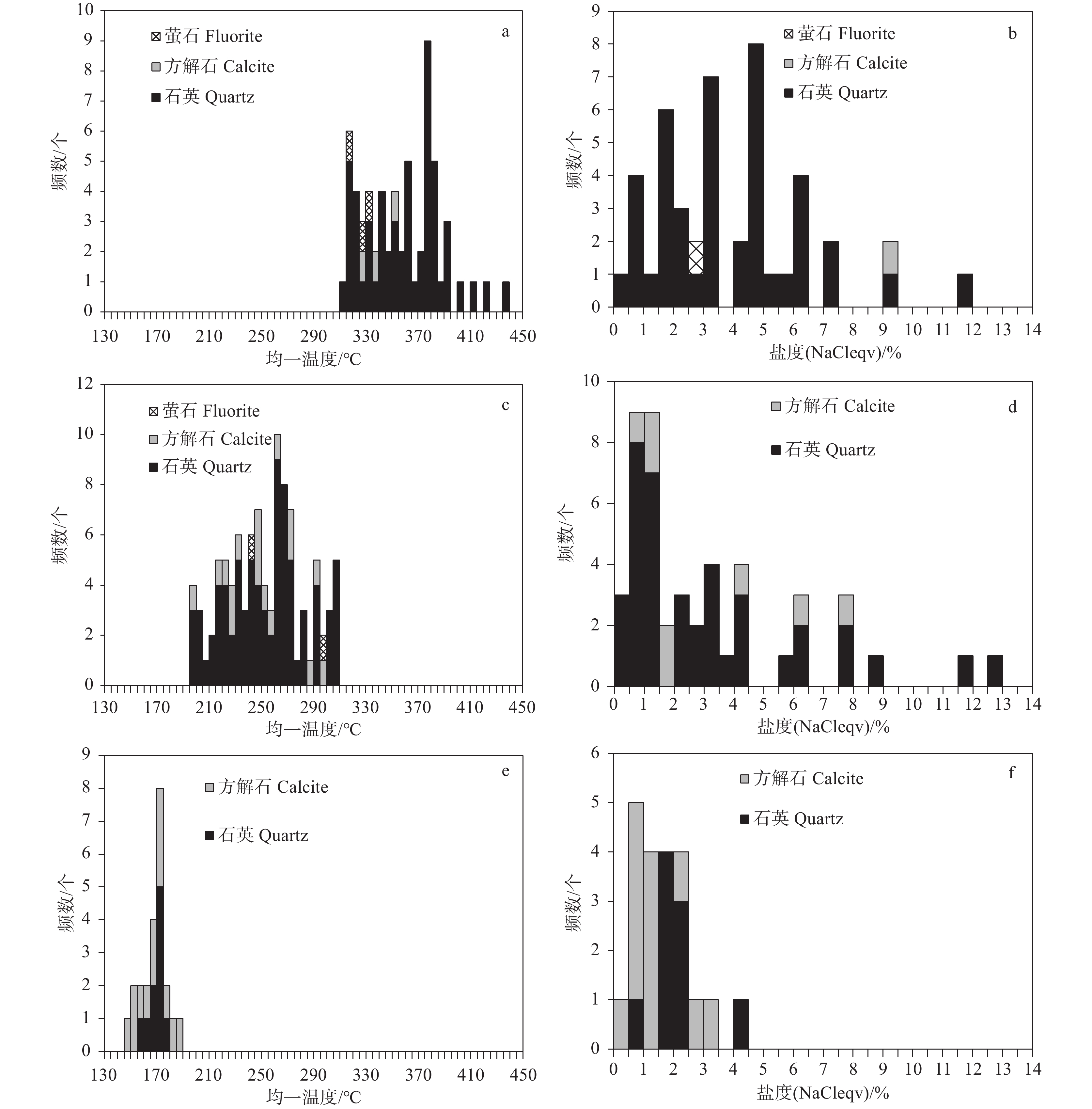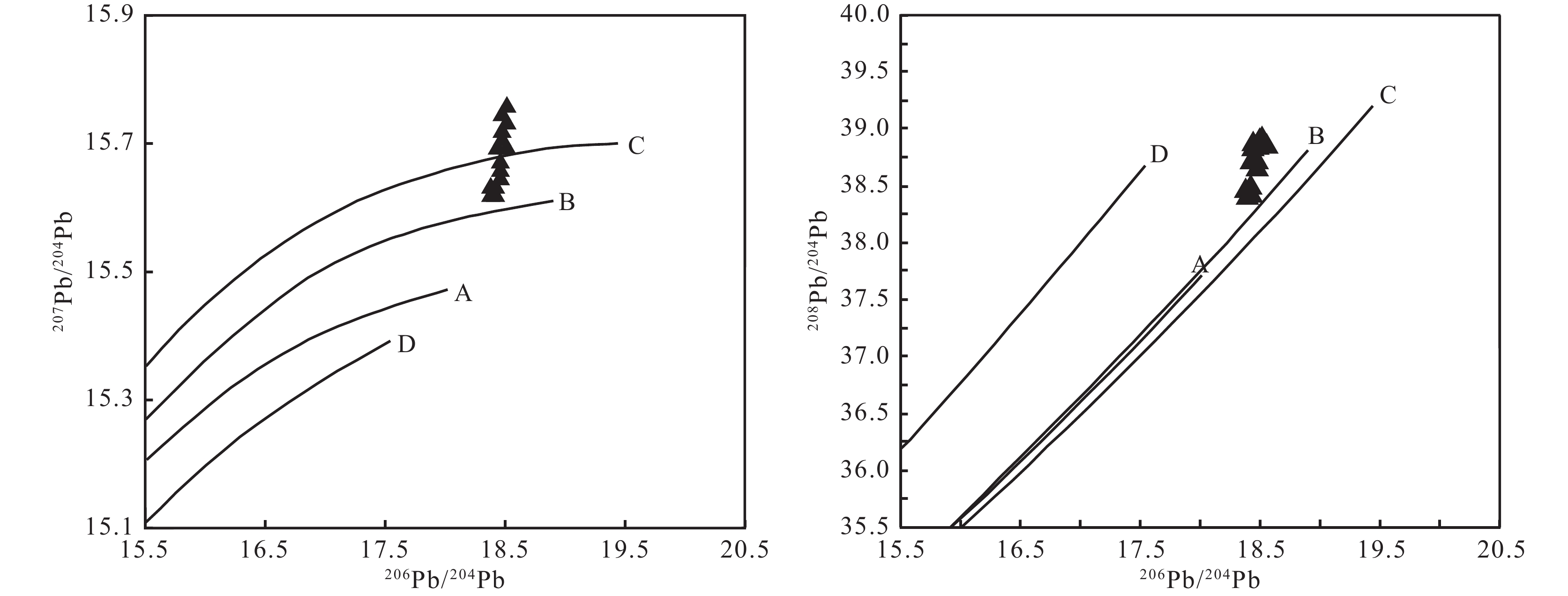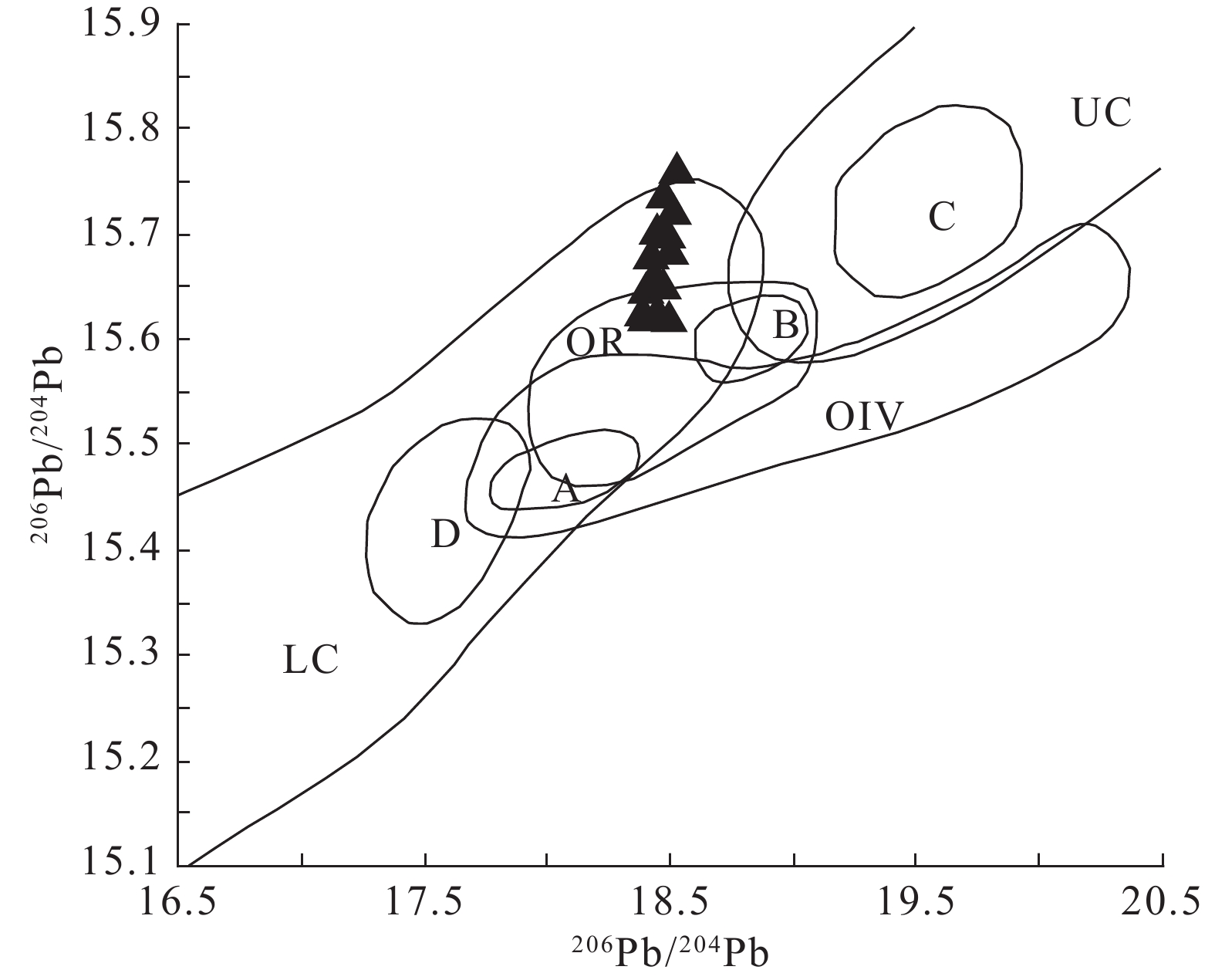Discussion on the ore−forming fluids, materials sources and genesis of Erdaohe Pb−Zn−Ag deposit, Inner Mongolia
-
摘要:
研究目的 二道河铅锌银矿位于大兴安岭中段,是近年来发现的具有代表性的大型矽卡岩型矿床,通过对该矿床成因的研究将有助于指导大兴安岭中段多金属矿床的勘查工作。
研究方法 本文在野外地质调查的基础上,选取各成矿阶段热液石英进行流体包裹体研究,并结合矿石S、Pb同位素与方解石C、O同位素,探讨该矿床成矿流体及物质来源。
研究结果 二道河矿床先后经历了矽卡岩阶段、石英硫化物阶段、石英碳酸盐阶段。测温结果显示,热液石英中的包裹体以气液两相为主,矽卡岩阶段石英中包裹体均一温度为310~435℃,盐度为11.7%~0.71% NaCleqv;石英−硫化物阶段石英中包裹体均一温度为195~310℃,盐度为12.9%~0.35% NaCleqv;石英−碳酸盐阶段石英中包裹体均一温度为148~195℃,盐度为4.18%~0.35% NaCleqv。方解石C、O同位素显示矿床经历了水岩反应,并有大气降水的加入。矿石硫同位素δ34S为5.4‰~10.0‰,来源于岩浆与地层的混合硫;铅同位素特征参数表明,铅的来源与造山相关的岩浆作用有关,以上地壳铅为主并混合了少量的深源铅。
结论 综上所述,二道河铅锌银矿的成矿流体与物质来源应与蒙古—鄂霍茨克洋闭合造山后伸展导致的大规模岩浆作用有关。
Abstract:This paper is the result of mineral exploration engineering.
Objective The Erdaohe silver−lead−zinc deposit is located in the middle section of the Greater Khingan Range. It is a representative large−scale skarn−type deposit discovered in recent years. Studying the origin of this deposit will help guide the exploration of polymetallic deposits in the middle section of the Greater Khingan Range.
Methods On the basis of field geological survey, this paper made research on the fluid inclusion in the keatite selected at each stage of mineralization, and discussed the ore−forming fluid and material sources in combination with the S and Pb isotopes of ore and the C and O isotopes of calcite.
Results The research result showed the formation of the deposit throughout the process from the skarn stage to the quarte−sulfide stage and to the quartz carbonate stage. According to the temperature measurement result, the inclusion in keatite was mainly characterized by gas−liquid phase, with the homogenization temperature of 310–435℃ at the skarn stage, 195–310℃ at the quarte−sulfide stage and 148–195℃ at the quartz carbonate stage, and the salinity of 11.7%–0.71% NaCleqv at the skarn stage, 12.9%–0.35% NaCleqv at the quartz−sulfide stage and 4.18%–0.35% NaCleqv at the quartz−carbonate stage. The C and O isotopes of calcite indicated a water−rock reaction of the deposit, in which atmospheric precipitation was found. The δ34S value of the S isotope of ore was 5.4‰–10.0‰ from a mixture of sulfurs in magma and strata; as per the characteristic parameter of lead isotope, the source of lead was associated with the orogeny−related magmatism, where the lead was mostly from the upper crust, and slightly from the deep source.
Conclusions Accordingly, the ore−forming fluid and material sources were considered the products of the large−scale magmatism caused by the extension after the closure of Mongolia−Okhotsk for orogeny.
-

-
图 1 二道河铅锌银矿区域地质图(修改自内蒙古第三地质矿产勘查开发有限责任公司, 2012
1 )Figure 1.
图 7 二道河铅锌银多金属矿床方解石的C、O同位素值分布(改自刘家军等, 2004)
Figure 7.
图 8 二道河铅锌银矿石铅同位素组成(据Zartman and Doe, 1981)
Figure 8.
图 9 铅同位素Δβ−Δγ分类(据朱炳泉等, 1998)
Figure 9.
图 10 铅同位素构造环境判别(据朱炳泉等, 1998)
Figure 10.
表 1 二道河铅锌银矿热液矿物生成顺序
Table 1. Paragenetic sequence of hydrothermal minerals in the Erdaohe Pb−Zn−Ag polymetallic deposit
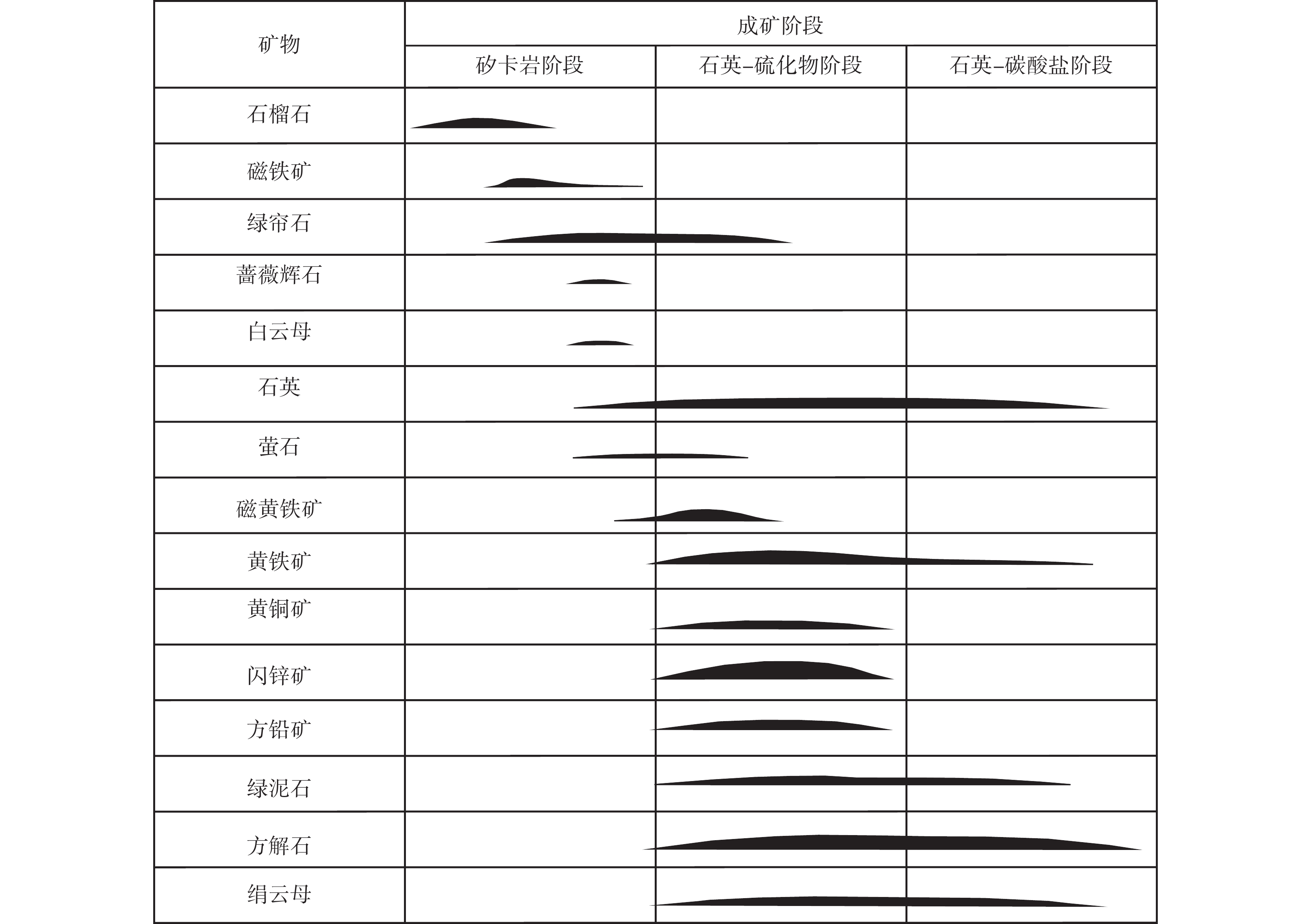
表 2 二道河铅锌银矿流体包裹体测温结果
Table 2. Results of microthermometric measurements of fluid inclusions in the Erdaohe Pb−Zn−Ag polymetallic deposit
成矿温度 成矿阶段 测试矿物 大小/μm 气相比/% 冰点/℃ 盐度/% NaCleqv 均一温度/℃ 高温 矽卡岩阶段 Qtz、Fl、Cal 3~18 20~40 −1.1 11.7~0.71 310~435 中温 石英−硫化物阶段 Qtz、Fl、Cal 5~22 15~30 −0.2 12.9~0.35 195~310 低温 石英−碳酸盐阶段 Qtz、Cal 3~35 10~15 −0.5 4.18~0.35 148~195 表 3 二道河铅锌银矿样品碳、氧同位素组成
Table 3. Carbon and oxygen isotope compositions of calcite in the Erdaohe Pb−Zn−Ag polymetallic deposit
样品编号 矿物 δ13CV-PDB/‰ δ18OV-PDB/‰ δ18OV-SMOW/‰ T/K $\delta^{18} \mathrm{O}_{{\mathrm{H}}_2 \mathrm{O} }$ /‰ED405-253 方解石 −8.5 −31.7 −1.7 439 −0.8 ED103-46.4 方解石 −4.1 −22.7 −7.5 439 −6.5 ED102-152 方解石 −3.8 −38.4 −8.7 439 −7.7 ED701-119 方解石 −2.4 −36.6 −6.8 439 −5.9 表 4 二道河矿区硫同位素组成
Table 4. Sulfer isotope composition of the Erdaohe deposit
样号 测试矿物 δ34SV-CDT/‰ ED403-195 黄铁矿 8.8 ED104-268 黄铁矿 9.3 ED701-9 黄铁矿 7.7 ED701-47 黄铁矿 8.5 ED701-39 黄铁矿 8 ED705-50 黄铁矿 9.2 ED104-30 黄铁矿 10 ED701-9 闪锌矿 7.5 ED701-47 闪锌矿 7.3 ED102-47 闪锌矿 7.7 ED102-59 闪锌矿 7.4 ED102-109 闪锌矿 8.1 ED705-50 闪锌矿 9 ED103-36 方铅矿 5.5 ED701-47 方铅矿 6.1 ED701-39 方铅矿 5.7 ED102-59 方铅矿 5.9 ED102-76 方铅矿 5.4 ED707-167 方铅矿 6.5 表 5 二道河铅锌银矿石铅同位素组成及参数
Table 5. Lead isotope parameters of the Erdaohe Pb−Zn−Ag ores
样品号 样品名称 206Pb/204Pb 207Pb/204Pb 208Pb/204Pb μ ω Th/U △α △β △γ ED102-47 方铅矿 18.417 15.640 38.480 9.540 37.030 3.760 77.360 20.850 36.110 ED701-9 方铅矿 18.420 15.635 38.460 9.530 36.880 3.750 76.880 20.490 35.210 ED701-18 方铅矿 18.424 15.646 38.498 9.550 37.120 3.760 77.950 21.250 36.700 ED705-30 方铅矿 18.398 15.628 38.436 9.520 36.840 3.750 76.170 20.060 34.880 ED705-50 方铅矿 18.518 15.764 38.894 9.780 39.360 3.890 89.480 29.320 50.720 ED701-18 闪锌矿 18.481 15.697 38.837 9.650 38.680 3.880 82.970 24.680 46.770 ED705-30 闪锌矿 18.461 15.652 38.731 9.560 37.930 3.840 78.600 21.560 42.120 ED705-169 闪锌矿 18.414 15.620 38.407 9.500 36.560 3.720 75.410 19.440 33.160 ED102-47 黄铁矿 18.462 15.677 38.768 9.610 38.310 3.860 81.010 23.320 44.440 ED102-136 黄铁矿 18.507 15.720 38.909 9.690 39.060 3.900 85.240 26.230 49.130 ED701-18 黄铁矿 18.472 15.696 38.658 9.650 37.980 3.810 82.860 24.640 42.180 ED701-98 黄铁矿 18.449 15.667 38.735 9.590 38.160 3.850 80.030 22.660 43.420 ED705-30 黄铁矿 18.492 15.732 38.865 9.710 39.080 3.900 86.360 27.130 49.050 ED705-169 黄铁矿 18.480 15.675 38.759 9.600 38.160 3.850 80.850 23.120 43.520 -
[1] Bai Daming, Fu Guoli, Nie Fengjun, Jiang Sihong, Liu Yifei. 2011. Integrated Ore–prospecting model for the skarn polymetallic deposit in southeastern Inner Mongolia[J]. Journal of Jinlin University (Earth Science Edition), 41(6): 1968−1976 (in Chinese with English abstract).
[2] Baker T, Van Achterberg E, Ryan C G, Lang J R. 2004. Composition and evolution of ore fluids in a magmatic–hydrothermal skarn deposit[J]. Geology, 32(2): 117−120. doi: 10.1130/G19950.1
[3] Bodnar R J. 1993. Revised equation and table for determining the freezing point depression of H2O–NaCl solutions[J]. Geochimica et Cosmochimica Acta, 57(3): 683−684. doi: 10.1016/0016-7037(93)90378-A
[4] Chaussidon M, Lorand J. 1990. Sulphur isotope composition of orogenic spinel lherzolite massifs from Ariege (North–Eastern Pyrenees, France): An ion microprobe study[J]. Geochimica et Cosmochimica Acta, 54(10): 2835−2846. doi: 10.1016/0016-7037(90)90018-G
[5] Chen Yongqing, Zhou Ding, Guo Lingfen. 2014. Genetic study on the Huaaobaote Pb–Zn–Ag polymetallic deposit in Inner Mongolia: Evidence from fluid inclusions and S, Pb, H, O isotopes[J]. Journal of Jinlin University (Earth Science Edition), 44(5): 1478−1491 (in Chinese with English abstract).
[6] Cui Xuewu, Jiang Shenghua, Li Hongbao, Chang Yaohui. 2015. Integrated prospecting model of Erdaohe silver–lead–zinc deposit in the Zhalantun area, Inner Mongolia[J]. Mineral Exploration, 6(6): 667−678 (in Chinese with English abstract).
[7] Ding Weipin, Xie Caifu, Huang Cheng, Zhang Bin, Xin Zhuo, Zhan Huasi, Zheng Lilong, Kong Fanquan, Wang Hongbing, Huang Fulin. 2022. Sources of Permian lead-zine ore-forming materials in Sichuan‒Yunnan‒Guizhou area: C‒H‒O‒S‒Pb isotope constraints: An example from Taipingzi lead-zinc deposit in Yunnan Provinces[J]. Geology in China, 49(6): 1845‒1861 (in Chinese with English abstract).
[8] Fontbote L, Gorzawski H. 1990. Genesis of the Mississippi valley–type Zn–Pb deposit of San Vicente, central Peru: Geologic and isotopic (Sr, O, C, S, Pb) evidence[J]. Economic Geology, 85(7): 1402−1437. doi: 10.2113/gsecongeo.85.7.1402
[9] Ge Wenchun, Wu Fuyuan, Zhou Changyong, Zhang Jiheng. 2005. Zircon U–Pb ages and its significance of the Mesozoic granites in the Wulanhaote region, central Da Hinggan Mountain[J]. Acta Petrologica Sinica, 21(3): 749−762 (in Chinese with English abstract).
[10] Gun Minshan, Lü Xinbiao, Li Jie, Xu Yiqun, Wang Lin, Wang Shaobin. 2015. Study on fluid inclusions in Erdaohe lead–zinc polymetallic deposit in Inner Mongolia[J]. Acta Mineralogica Sinica, 35(S1): 579 (in Chinese).
[11] Guo Xiangguo. 2020. Metallogenesis of Erdaohe Skarn–type Lead–Zinc Deposit in the Middle Segment of the Great Hinggan Range[D]. Beijing: China University of Geosciences (Beijing).
[12] Hall D L, Sterner S M, Bodnar R J. 1988. Freezing point depression of NaCl–KCl–H2O solutions[J]. Economic Geology, 83(1): 197−202. doi: 10.2113/gsecongeo.83.1.197
[13] Han G Q, Liu Y J, Neubauer F, Genser J, Li W, Zhao Y L, Liang C Y. 2011. Origin of terranes in the eastern Central Asian Orogenic Belt, NE China: U–Pb ages of detrital zircons from Ordovician–Devonian sandstones, North Da Xing'an Mts.[J]. Tectonophysics, 511(3/4): 109−124. doi: 10.1016/j.tecto.2011.09.002
[14] He Jing, Huang Ming, Cong Yanan. 2019. Geological characteristics and prospecting indicators of Erdaohe silver–lead–zinc deposit in Inner Mongolia[J]. Inner Mongolia Science Technology and Economy, (12): 58 (in Chinese with English abstract).
[15] Heinrich C A. 2007. Fluid–fluid interactions in magmatic–hydrothermal ore formation[J]. Reviews in Mineralogy and Geochemistry, 65(1): 363−387. doi: 10.2138/rmg.2007.65.11
[16] Kang Yongjian, She Hongquan, Xiang Anping, Tian Jing, Li Jinwen, Yang Yuncheng, Guo Zhijun, Dong Xuzhou. 2014. Indo–Chinese magmatic activity in the Badaguan ore district of Inner Moingolia and its metallogenic implications[J]. Geology in China, 41(4): 1215−1225 (in Chinese with English abstract).
[17] Leng Chengbiao, Zhang Xingchun, Wang Shouxu, Qin Zhaojian, Wu Kongwen, Ren Tao. 2009. Advances of researches on the evolution of ore–forming fluids and the vapor transport of metals in magmatic–hydrothermal systems[J]. Geological Review, 55(1): 100−112 (in Chinese with English abstract).
[18] Lin W, Charles N, Chen Y, Chen K, Faure M, Wu L, Wang F, Li Q L, Wang J, Wang Q C. 2013. Late Mesozoic compressional to extensional tectonics in the Yiwulüshan massif, NE China and its bearing on the evolution of the Yinshan–Yanshan orogenic belt: Part I: Structural analyses and geochronological constraints[J]. Gondwana Research, 23(1): 78−94. doi: 10.1016/j.gr.2012.02.012
[19] Liu Jiajun, He Mingqin, Li Zhiming, Liu Yuping, Li Zhaoying, Zhang Qian, Yang Weiguang, Yang Aiping. 2004. Oxygen and carbon isotopic geochemistry of Baiyangping sliver–copper polymetallic ore concentration area in Lanping Basin of Yunnan Province and its significance[J]. Mineral Deposits, (1): 1−10 (in Chinese with English abstract).
[20] Liu Jianming, Zhang Rui, Zhang Qingzhou. 2004. The regional metallogeny of Da Hing Gan Ling, China[J]. Earth Science Frontiers, (1): 269−277 (in Chinese with English abstract).
[21] Liu Kai, Wu Taotao, Liu Jinlong, Bao Qingzhong, Du Shouying. 2018. Geochronology and geochemistry of volcanic rocks in Manketou'ebo Formation of Tulihe area, northern Da Hinggan Mountains[J]. Geology in China, 45(2): 367−376 (in Chinese with English abstract).
[22] Liu Yanrong, Guan Qiangbing, Zhang Haidong, Zhou Qunjun, Dang Shun'an. 2023. Sulfides Rb-Sr and zircon U‒Pb ages of the Erdaohezi Pb‒Zn deposit in the western slope of the Great Xing'an Range and their constraints on tectonic setting[J]. Geological Bulletin of China, 42(11): 1843‒1853 (in Chinese with English abstract).
[23] Miao L C, Fan W M, Liu D Y, Zhang F Q, Shi Y R, Guo F. 2008. Geochronology and geochemistry of the Hegenshan ophiolitic complex: Implications for late–stage tectonic evolution of the Inner Mongolia–Daxinganling Orogenic Belt, China[J]. Journal of Asian Earth Sciences, 32(5/6): 348−370. doi: 10.1016/j.jseaes.2007.11.005
[24] Nie Fengjun, Zhang Wanyi, Du Andao, Jiang Sihong, Liu Yan. 2007. Re–Os isotopic age dating of molybdenite separates from the Chaobuleng iron–polymetallic deposit, Dong Ujimqin Banner, Inner Mongolia[J]. Acta Geoscientica Sinica, 28(4): 315−323 (in Chinese with English abstract).
[25] Ohmoto H. 1972. Systematics of sulfur and carbon isotopes in hydrothermal ore deposits[J]. Economic Geology, 67(5): 551−578. doi: 10.2113/gsecongeo.67.5.551
[26] O'Neil J R, Clayton R N, Mayeda T K. 1969. Oxygen isotope fractionation in divalent metal carbonates[J]. The Journal of Chemical Physics, 51(12): 5547−5558. doi: 10.1063/1.1671982
[27] Ren Jishun, Niu Baogui, Liu Zhigang. 1999. Soft collision, superposition orogeny and polycyclic suturing[J]. Earth Science Frontiers, (3): 85−93 (in Chinese with English abstract).
[28] Rollinson H. 1993. Using Geochemical Data: Evaluation, Presentation, Interpretation[M]. London: Longman Scientific and Technical, 52–61.
[29] Rye R O, Ohmoto H. 1974. Sulfur and carbon isotopes and ore genesis: A review[J]. Economic Geology, 69(6): 826−842. doi: 10.2113/gsecongeo.69.6.826
[30] Sakai H. 1968. Isotopic properties of sulfur compounds in hydrothermal processes[J]. Geochemical Journal, 2(1): 29−49. doi: 10.2343/geochemj.2.29
[31] Seal R R. 2006. Sulfur isotope geochemistry of sulfide minerals[J]. Reviews in Mineralogy and Geochemistry, 61(1): 633−677. doi: 10.2138/rmg.2006.61.12
[32] Shao Jian, Mou Baolei, He Guoqi, Zhang Lüqiao. 1997. The geological function of northern North China during the superimposition of the paleo–Asian and paleo–Pacific regions[J]. Science in China (Earth Science), (5): 390−394 (in Chinese).
[33] Shao Jidong, Wang Hui, Zhang Mei, Zhao Wentao. 2011. Division of tectonic units in Inner Mongolia and its geological characteristics[J]. Western Resources, (2): 51−56 (in Chinese).
[34] She Hongquan, Li Honghong, Li Jinwen, Zhao Shibao, Tan Gang, Zhang Dequan, Jinjun, Dong Yingjun, Feng Chengyou. 2009. The metallogenetical characteristics and prospecting direction of the copper–lead–zinc polymetal deposits in the northern–central Daxing'anling Mountain, Inner Monglia[J]. Acta Geologica Sinica, 83(10): 1456−1472 (in Chinese with English abstract).
[35] She Hongquan, Li Jinwen, Xiang Anping, Guan Jidong, Yang Yuncheng, Zhang Dequan, Tan Gang, Zhang Bin. 2012. U–Pb ages of the zircons from primary rocks in middle–northern Daxinganling and its implications to geotectonic evolution[J]. Acta Petrologica Sinica, (2): 217−240 (in Chinese with English abstract).
[36] Shi Yonghong, Wang Yong, Chen Bailin, Tan Renwen, Gao Yun, Shen Jinghui. 2022. Characteristics of silicon-calcium surface ore-controlling in Fengtai ore‒concentration areas, West Qinling Mountains: Examples from Qiandongshan Pb-Zn deposit[J]. Geology in China, 49(1): 226‒240 (in Chinese with English abstract).
[37] Sun Deyou, Wu Fuyuan, Zhang Yanbin, Gao Shan. 2004. The final closing time of the west Lamulun River–Changchun–Yanji Plate suture zone: Evidence from the Dayushan granitic pluton, Jinlin Province[J]. Journal of Jinlin University (Earth Science Edition), 34(2): 174−181 (in Chinese with English abstract).
[38] Tang Zongyuan. 2019. Petrogenesis and Geodynamic Mechanism of the Mesozoic Volcanic Rocks in the Central Great Xing'an Range[D]. Changchun: Jilin University, 1–174.
[39] Wang Jianjun, Wang Zhong, Zhang Da, Yu Qiuye, Di Yongjun, Sun Yanjie, Xiong Guangqiang, Zhao Hongtao, Liu Min. 2013. Geological characteristics and origin of Erdaohe lead–zinc–silver–copper deposit in Zhalantun, Inner Mongolia[J]. Acta Mineralogica Sinica, 33(S2): 498−499 (in Chinese).
[40] Wang T, Guo L, Zhang L, Yang Q, Zhang J, Tong Y, Ye K. 2015. Timing and evolution of Jurassic–Cretaceous granitoid magmatism in the Mongol–Okhotsk belt and adjacent areas, NE Asia: Implications for transition from contractional crustal thickening to extensional thinning and geodynamic settings[J]. Journal of Asian Earth Sciences, 97: 365−392. doi: 10.1016/j.jseaes.2014.10.005
[41] Wang Xiaohu, Hou Zengqian, Song Yucai, Wang Guanghui, Zhang Hongrui, Zhang Chong, Zhuang Tianming, Wang Zhe, Zhang Tianfu. 2012. Baiyangping Pb–Zn–Cu–Ag polymetallic deposit in Lanping basin: A discussion on characteristics and source of ore–forming fluids and source of metallogenic materials[J]. Earth Science—Journal of China University of Geosciences, 37(5): 1015−1028 (in Chinese with English abstract).
[42] Williams–Jones A E, Samson I M, Ault K M, Gagnon J E, Fryer B J. 2010. The genesis of distal zinc skarns: Evidence from the Mochito deposit, Honduras[J]. Economic Geology, 105(8): 1411−1440. doi: 10.2113/econgeo.105.8.1411
[43] Wu F Y, Zhao G C, Sun D Y, Wilde S A, Yang J H. 2007. The Hulan Group: its role in the evolution of the Central Asian Orogenic Belt of NE China[J]. Journal of Asian Earth Sciences, 30(3/4): 542−556.
[44] Xiao Qinghui. 2002. Granite Research Thinking and Methods[M]. Beijing: Geological Publishing House (in Chinese).
[45] Yang Fating. 2018. Metallogenic regularity and prospecting prediction of Erdaohe silver polymetallic deposit in the middle section of Daxinganling[J]. Western Resources, (6): 71−72 (in Chinese).
[46] Yao Xiaofeng, Ye Tianzhu, Tang Juxing, Zheng Wenbao, Ding Shuai, Li Yongsheng, Zhen Shimin. 2014. The effect of Si–Ca interface on skarn formation and polymetallic mineralization in the Jiama deposit, Xizang[J]. Geology in China, 41(5): 1577−1593 (in Chinese with English abstract).
[47] Zartman R E, Doe B R. 1981. Plumbotectonics—the model[J]. Tectonophysics, 75(1/2): 135−162.
[48] Zeng Qingdong, Liu Jianming, Chu Shaoxiong, Guo Yunpeng, Gao Shuai, Guo Lixiang, Zhai Yuanyuan. 2016. Ploy–metal mineralization and exploration potential in Southern segment of the Da Hinggan Mountains[J]. Journal of Jinlin University (Earth Science Edition), 46(4): 1100−1123 (in Chinese with English abstract).
[49] Zhai Degao, Liu Jiajun, Wang Jianping, Peng Runmin, Wang Shouguang, Li Yuxi, Chang Zhongyao. 2009. Re–Os isotopic chronology of molybdenite from the Taipinggou porphyry–type molybdenum deposit in Inner Mongolia and its geological significance[J]. Geoscience, 23(2): 262−268 (in Chinese with English abstract).
[50] Zhang Changqing, Ye Tianzhu, Wu Yue, Wang Chenghui, Ji Hai, Li Li, Zhang Tingting. 2012. Discussion on controlling role of Si–Ca boundary in locating Pb–Zn deposits and its prospecting significance[J]. Mineral Deposits, 31(3): 405−416 (in Chinese with English abstract).
[51] Zhang Geli, Tian Tao, Wang Ruiting, Gao Weihong, Chang Zongdong. 2020. S, Pb isotopic composition of the Dongtangzi Pb−Zn deposit in the Fengtai ore concentration area of Shaanxi Province for tracing sources of ore−forming materials[J]. Geology in China, 47(2): 472−484 (in Chinese with English abstract).
[52] Zhang Jing, Shao Jun, Jiang Shan, Yang Hongzhi. 2017. A study of the stable isotope geochemistry of Erdaohe Pb–Zn ore deposit in Inner Mongolia[J]. Geological Review, 63(S1): 225−227 (in Chinese).
[53] Zheng Yongfei, Xu Baolong, Zhou Gentao. 2000. Geochemical studies of stable isotopes in minerals[J]. Earth Science Frontiers, (2): 299−320 (in Chinese with English abstract).
[54] Zhu Bingquan, Li Xianhua, Dai Tongmo. 1998. The Theory and Application of Isotope System in Earth Science—Also on the Evolution of Crust and Mantle in Chinese Mainland[M]. Beijing: Science Press (in Chinese).
[55] 白大明, 付国立, 聂凤军, 江思宏, 刘翼飞. 2011. 内蒙古东南部矽卡岩型金属矿床的综合找矿模式[J]. 吉林大学学报(地球科学版), 41(6): 1968−1976.
[56] 陈永清, 周顶, 郭令芬. 2014. 内蒙古花敖包特铅锌银多金属矿床成因探讨: 流体包裹体及硫、铅、氢、氧同位素证据[J]. 吉林大学学报(地球科学版), 44(5): 1478−1491.
[57] 崔学武, 姜胜华, 李洪宝, 常耀辉. 2015. 内蒙古二道河银铅锌矿床综合找矿模式[J]. 矿产勘查, 6(6): 667−678. doi: 10.3969/j.issn.1674-7801.2015.06.003
[58] 丁伟品, 谢财富, 黄诚, 张斌, 辛卓, 詹华思, 郑立龙, 孔凡全, 王红兵, 黄福林. 2022. 川滇黔二叠系铅锌成矿物质来源:C‒H‒O‒S‒Pb同位素制约—以云南太平子铅锌矿为例[J]. 中国地质, 49(6): 1845‒1861.
[59] 葛文春, 吴福元, 周长勇, 张吉衡. 2005. 大兴安岭中部乌兰浩特地区中生代花岗岩的锆石U–Pb年龄及地质意义[J]. 岩石学报, 21(3): 749−762. doi: 10.3321/j.issn:1000-0569.2005.03.015
[60] 衮民汕, 吕新彪, 李杰, 徐益群, 王琳, 王邵斌. 2015. 内蒙古二道河铅锌多金属矿床流体包裹体研究[J]. 矿物学报, 35(S1): 579.
[61] 郭向国. 2020. 大兴安岭中段二道河矽卡岩型铅锌矿成矿作用研究[D]. 北京: 中国地质大学(北京).
[62] 和静, 黄明, 丛亚楠. 2019. 内蒙古二道河银铅锌矿床地质特征与找矿标志[J]. 内蒙古科技与经济, (12): 58.
[63] 康永建, 佘宏全, 向安平, 田京, 李进文, 杨郧城, 郭志军, 董旭舟. 2014. 内蒙古八大关矿区印支期岩浆活动及其找矿意义[J]. 中国地质, 41(4): 1215−1225. doi: 10.3969/j.issn.1000-3657.2014.04.015
[64] 冷成彪, 张兴春, 王守旭, 秦朝建, 吴孔文, 任涛. 2009. 岩浆−热液体系成矿流体演化及其金属元素气相迁移研究进展[J]. 地质论评, 55(1): 100−112. doi: 10.3321/j.issn:0371-5736.2009.01.012
[65] 刘家军, 何明勤, 李志明, 刘玉平, 李朝阳, 张乾, 杨伟光, 杨爱平. 2004. 云南白秧坪银铜多金属矿集区碳氧同位素组成及其意义[J]. 矿床地质, (1): 1−10. doi: 10.3969/j.issn.0258-7106.2004.01.001
[66] 刘建明, 张锐, 张庆洲. 2004. 大兴安岭地区的区域成矿特征[J]. 地学前缘, (1): 269−277. doi: 10.3321/j.issn:1005-2321.2004.01.024
[67] 刘凯, 吴涛涛, 刘金龙, 鲍庆中, 杜守营. 2018. 大兴安岭北段图里河地区满克头鄂博组火山岩年代学及地球化学[J]. 中国地质, 45(2): 367−376. doi: 10.12029/gc20180211
[68] 刘艳荣, 关强兵, 张海东, 周群君, 党顺安. 2023. 大兴安岭西坡二道河子铅锌矿床硫化物Rb‒Sr、锆石U‒Pb年龄及其对构造背景的制约[J]. 地质通报, 42(11): 1843‒1853.
[69] 聂凤军, 张万益, 杜安道, 江思宏, 刘妍. 2007. 内蒙古朝不楞矽卡岩型铁多金属矿床辉钼矿铼–锇同位素年龄及地质意义[J]. 地球学报, 28(4): 315−323. doi: 10.3321/j.issn:1006-3021.2007.04.001
[70] 任纪舜, 牛宝贵, 刘志刚. 1999. 软碰撞、叠覆造山和多旋回缝合作用[J]. 地学前缘, (3): 85−93. doi: 10.3321/j.issn:1005-2321.1999.03.008
[71] 邵济安, 牟保磊, 何国琦, 张履桥. 1997. 华北北部在古亚洲域与古太平洋域构造叠加过程中的地质作用[J]. 中国科学(地球科学), (5): 390−394.
[72] 邵积东, 王惠, 张梅, 赵文涛. 2011. 内蒙古大地构造单元划分及其地质特征[J]. 西部资源, (2): 51−56.
[73] 佘宏全, 李红红, 李进文, 赵士宝, 谭刚, 张德全, 金俊, 董英君, 丰成友. 2009. 内蒙古大兴安岭中北段铜铅锌金银多金属矿床成矿规律与找矿方向[J]. 地质学报, 83(10): 1456−1472. doi: 10.3321/j.issn:0001-5717.2009.10.010
[74] 佘宏全, 李进文, 向安平, 关继东, 杨郧城, 张德全, 谭刚, 张斌. 2012. 大兴安岭中北段原岩锆石U–Pb测年及其与区域构造演化关系[J]. 岩石学报, 28(2): 217−240.
[75] 石永红, 王永, 陈柏林, 谭人文, 高允, 申景辉. 2022. 西秦岭凤太矿集区铅锌矿床硅钙面控矿作用—以铅硐山铅锌矿床为例[J]. 中国地质, 49(1): 226‒240.
[76] 孙德有, 吴福元, 张艳斌, 高山. 2004. 西拉木伦河—长春—延吉板块缝合带的最后闭合时间—来自吉林大玉山花岗岩体的证据[J]. 吉林大学学报 (地球科学版), 34(2): 174−181.
[77] 唐宗源. 2019. 大兴安岭中段中生代火山岩成因及地球动力学机制[D]. 长春: 吉林大学, 1–174.
[78] 王建军, 王忠, 张达, 于秋野, 狄永军, 孙燕杰, 熊光强, 赵红涛, 刘敏. 2013. 内蒙古扎兰屯二道河铅锌银铜矿床地质特征及成因初探[J]. 矿物学报, 33(S2): 498−499.
[79] 王晓虎, 侯增谦, 宋玉财, 王光辉, 张洪瑞, 张翀, 庄天明, 王哲, 张天福. 2012. 兰坪盆地白秧坪铅锌铜银多金属矿床成矿流体及成矿物质来源[J]. 地球科学(中国地质大学学报), 37(5): 1015−1028.
[80] 肖庆辉. 2002. 花岗岩研究思维与方法[M]. 北京: 地质出版社.
[81] 杨发亭. 2018. 大兴安岭中段二道河银多金属矿床成矿规律及找矿预测[J]. 西部资源, (6): 71−72. doi: 10.3969/j.issn.1672-562X.2018.06.029
[82] 姚晓峰, 叶天竺, 唐菊兴, 郑文宝, 丁帅, 李永胜, 甄世民. 2014. 西藏甲玛矿床硅钙界面对矽卡岩成岩及多金属成矿的影响[J]. 中国地质, 41(5): 1577−1593. doi: 10.3969/j.issn.1000-3657.2014.05.014
[83] 曾庆栋, 刘建明, 禇少雄, 郭云鹏, 高帅, 郭理想, 翟媛媛. 2016. 大兴安岭南段多金属矿成矿作用和找矿潜力[J]. 吉林大学学报(地球科学版), 46(4): 1100−1123.
[84] 翟德高, 刘家军, 王建平, 彭润民, 王守光, 李玉玺, 常忠耀. 2009. 内蒙古太平沟斑岩型钼矿床Re–Os等时线年龄及其地质意义[J]. 现代地质, 23(2): 262−268. doi: 10.3969/j.issn.1000-8527.2009.02.010
[85] 张长青, 叶天竺, 吴越, 王成辉, 吉海, 李莉, 张婷婷. 2012. Si/Ca界面对铅锌矿床定位的控制作用及其找矿意义[J]. 矿床地质, 31(3): 405−416. doi: 10.3969/j.issn.0258-7106.2012.03.001
[86] 张革利, 田涛, 王瑞廷, 高卫宏, 常宗东. 2020. 凤太矿集区东塘子铅锌矿床S、Pb同位素组成对成矿物质来源的示踪[J]. 中国地质, 47(2): 472−484. doi: 10.12029/gc20200214
[87] 张璟, 邵军, 江山, 杨宏智. 2017. 内蒙古二道河铅锌矿床稳定同位素地球化学研究[J]. 地质论评, 63(S1): 225−227.
[88] 郑永飞, 徐宝龙, 周根陶. 2000. 矿物稳定同位素地球化学研究[J]. 地学前缘, (2): 299−320. doi: 10.3321/j.issn:1005-2321.2000.02.001
[89] 朱炳泉, 李献华, 戴橦谟. 1998. 地球科学中同位素体系理论与应用—兼论中国大陆壳幔演化[M]. 北京: 科学出版社.
-



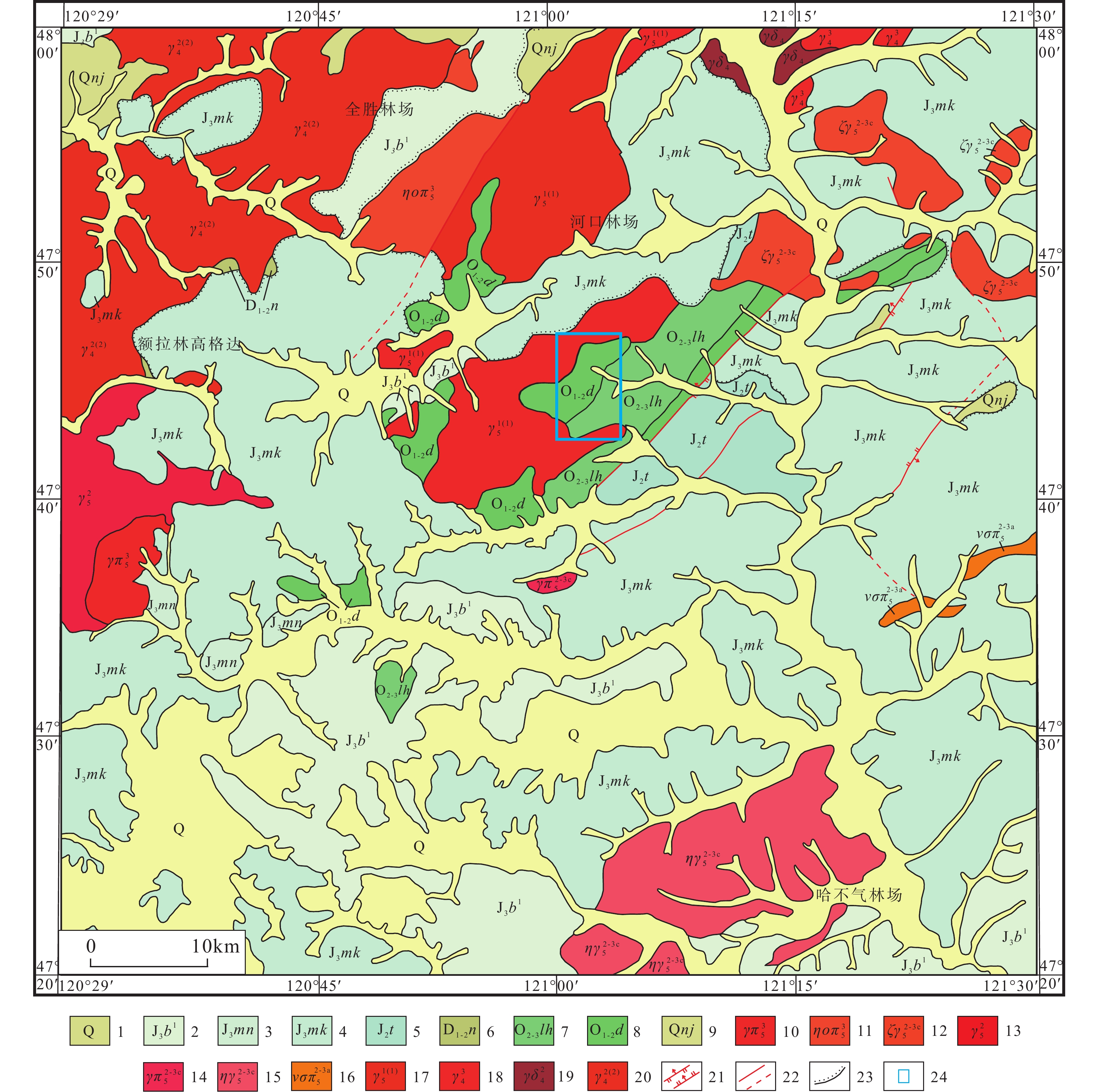
 下载:
下载:
